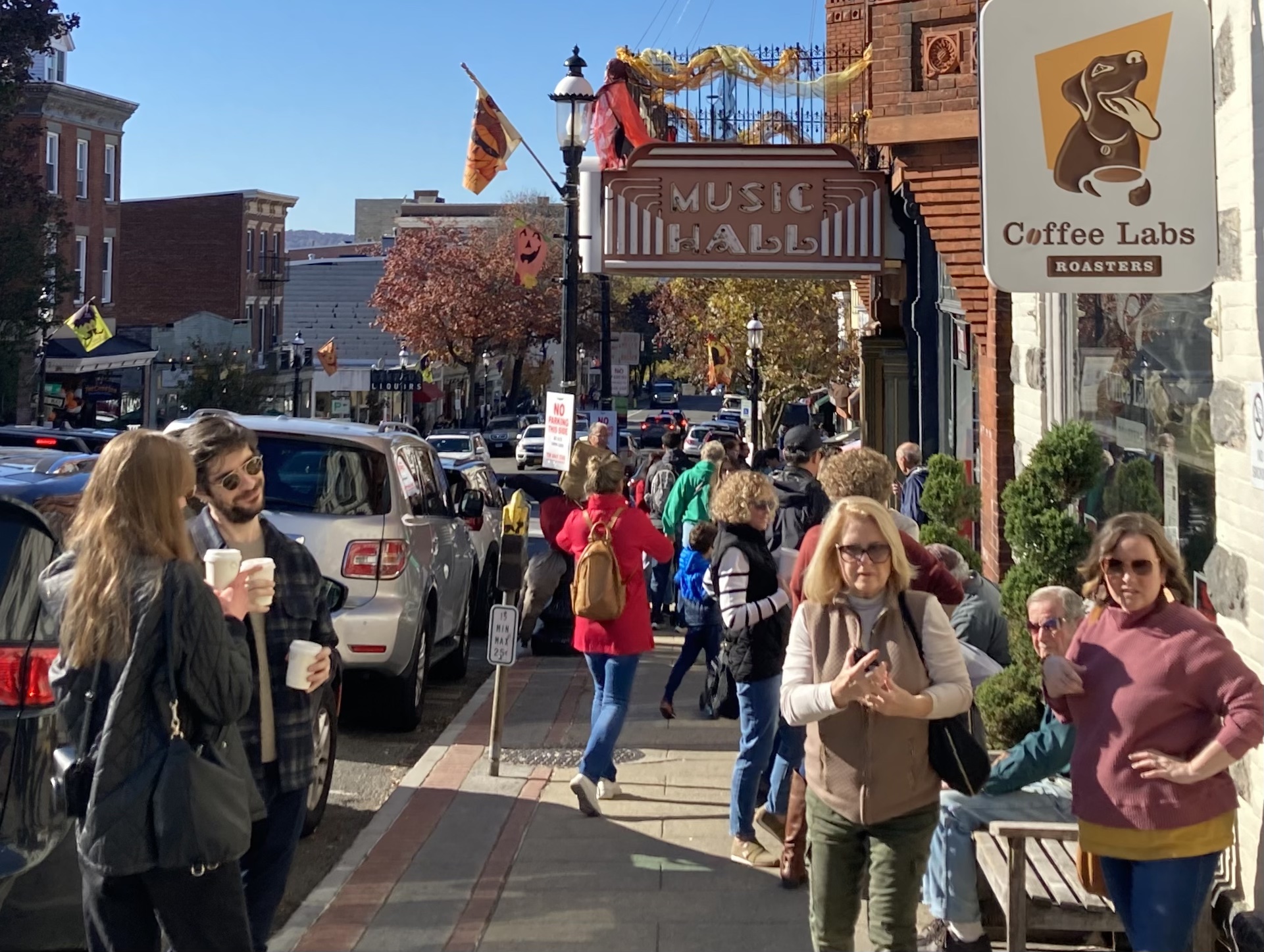
Shops, galleries, restaurants and a popular concert hall have transformed Tarrytown from a workaday waterfront town into one of the liveliest villages on the Hudson River. Photo by Mark Orwoll
By Mark Orwoll
Andy’s Café in Highland Falls, New York, looks like an Edward Hopper painting—a simple, old-school, Main Street diner where the patrons all seem to know one another. Even passersby who’ve already eaten stop by to say hi. Baseball caps hang from a hat rack near the front door.
Highland Falls is a classic version of 19th-century small-town America. The village is dressed in the style of a late-Victorian lady. A red-white-and-blue barber pole spins outside Mora’s salon. Moms and tots file into the public library for mid-morning story time.
Given the town’s demeanor, most people might consider a 120-year-old establishment like Andy’s Café to be the community mainstay. But when it opened in 1903, one iconic neighbor up the street already had been in business for 126 years. That would be West Point, the fortification dominating a strategic bend in the Hudson River.
Ever since the pilgrims’ arrival in 1620 America has dreamed of expanding westward. It was an article of faith. A Promised Land existed beyond the Appalachians, across the fertile Ohio Valley and on the other side of the Great Plains. America’s Manifest Destiny was to turn a continent into a country. Toward that end, the Mississippi River, Rocky Mountains and the foreboding deserts stretching north from Mexico were regarded as mere impediments, not barriers.
But America’s first frontier was the Hudson Valley. During its turbulent history, the Hudson River Valley has experienced war, inspired great works of art, witnessed treachery and powered the growth of one of the world’s most dynamic cities.
The Hudson River may run north to south, but in concert with the 19th-century Erie Canal it became the highway to the West, providing a detour past the natural obstacles that hampered expansion. Some say the Mississippi River is more famous, but you’ll find no more history-rich river (and few more worth visiting) than the Hudson.
West Point and the U.S. Military Academy
Excitement, whether thanks to football or otherwise, has rarely been in short supply around here, at least not since before the American War for Independence (1776-1783), in which West Point was vital to the Americans’ ultimate victory. General George Washington called West Point “the key to the continent.”
All one needs to do, to understand the importance of West Point, is consider the geography—whether from Google Maps’ aerial view or on an actual tour of the grounds. For most of its 144-mile length from New York City to Albany, the Hudson forms a straight line. But the river makes significant bends in three places, the sharpest of which is at West Point. The river narrows here, and the point of land creates a difficult S curve. As long as the point was garrisoned by the Americans, their British adversaries were unable to sail past it.
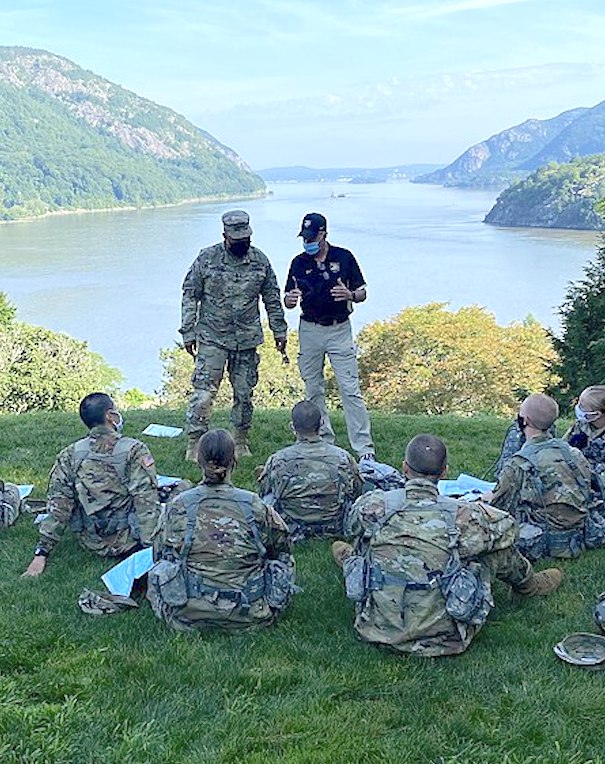
Future Army officers studying at the U.S. Military Academy hear an outdoor lecture while trying not to be distracted by one of the finest views along the entire length of the Hudson River. Public Domain photo
“The whole reason a military post was created here was to defend this river,” says my West Point tour guide, Chandrika, who has been giving these tours for nearly 14 years. “In those days, ships passing here had to come to a full stop to make that dangerous turn. That meant that a cannon battery on the heights could stop any ship from passing.”
The colonists stretched a massive iron chain across the river to improve the site’s natural defenses. The British, who had hoped that by dominating the river they could effectively cut off New England from the rest of the restless colonies, quickly recognized the futility of such efforts, and instead focused their attention on the south—Pennsylvania and Virginia. West Point stopped the British from an easy victory.
The Lower Hudson Valley
West Point sits in the Mid-Hudson Valley. Arguably, an even more intriguing section of the river lies to the south in the Lower Hudson Valley. That stretch, from New Amsterdam (later New York City) to Peekskill, was solidly Dutch in the 17th and 18th centuries. Among the most dominant families in that region was the Philipse clan, whose plantation, Philipsburg Manor, was 30 miles long, from the present-day South Bronx to Croton-on-Hudson, and eight miles wide, from the eastern banks of the Hudson nearly to the Connecticut border.
Much of the family’s land was leased to tenant farmers, who gave part of their grain harvest to the landlord. At the heart of the family’s business was the gristmill, in what is now the village of Sleepy Hollow. And at the heart of the gristmill were 23 enslaved Blacks who performed the bulk of the estate’s labor. When Adolph Philipse died in 1750 the slaves were itemized among an inventory of his “property.”
Today, Philipsburg Manor, which is open for tours, presents an unrivaled and fascinating glimpse into the region’s early colonization.
Sleepy Hollow Cemetery
After the Dutch ceded the region to Britain in 1664, the English and Hollanders continued to live together peacefully. The transition is easily followed by a visit to the local graveyard. Sleepy Hollow Cemetery may be one of the most atmospheric burial grounds anywhere. Century-old trees loom over tilting grave markers, some more than 200 years old. The mausoleums and headstones range from the plain and simple of the Colonial era to extravagant Victorian sepulchers belonging to Gilded Age titans like Andrew Carnegie, William Rockefeller, Jr., and Walter Chrysler.
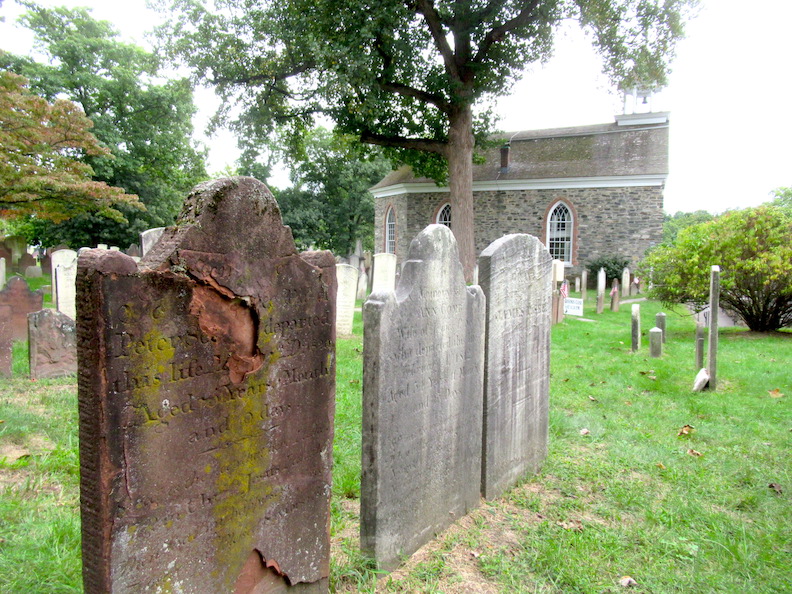
Sleepy Hollow Cemetery is a veritable timeline of settlement on the Hudson River, with stones recalling the early Dutch and colonial English settlers, as well as grand tombs of the Gilded Age. Photo by Mark Orwoll
The stone façade of the Old Dutch Church built by Frederick Philipse in 1697 sits at the cemetery’s entrance off Route 9. On cloudless days when the setting sun glows red, shadows glide across the churchyard tombs.
Dutch family names predominate nearest the sanctuary: Van Wart, Van Tassel, Van Nicholas, Van Aken. Farther from the church, the Dutch surnames are supplanted by plain and simple English names: Brown, Dawson, Hall, King, Taylor. There are veterans of the Revolutionary War, including immigrants like “Hulda of Bohemia,” a woman who was “felled by the British while protecting the militia” in 1777. Here lie the remains of early settlers named D’Esopo, Schlaffer, and Badeau. It’s almost as if the settlement history of the Hudson River Valley can be gleaned within 50 paces of the portico of the Old Dutch Church.
One of the most sought-out headstones in the cemetery is that of a man who was neither slave nor soldier, but a storyteller. His name was Washington Irving.
Washington Irving, Chronicler of the Hudson Valley
In The Sketch Book of Geoffrey Crayon, Gent., published in 1819, Irving introduced the world to Rip Van Winkle, Ichabod Crane, Katrina Van Tassel, Brom Bones, and other memorable characters set in the dusk of the Dutch dominance of the Hudson Valley. In so doing, he became the first American writer to put American history and geography into fiction.
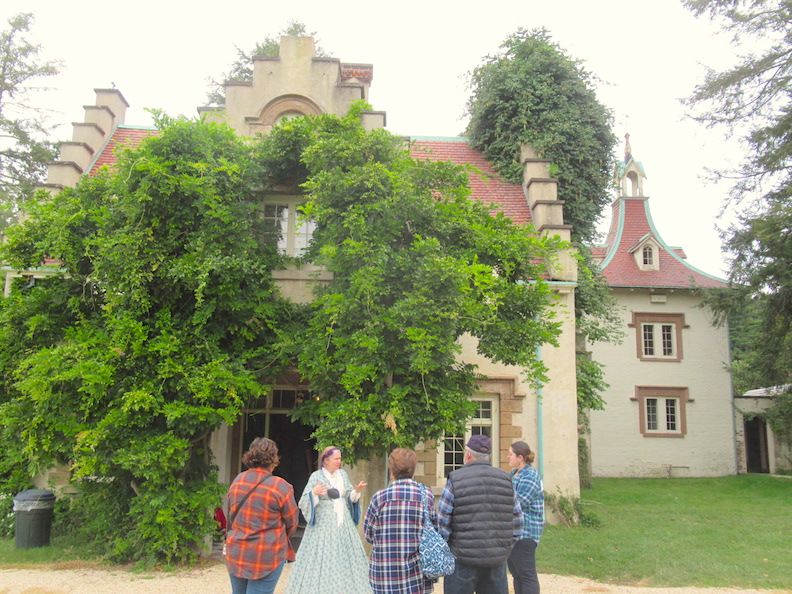
A period-garbed docent welcomes visitors outside Sunnyside, home to author Washington Irving. Irving’s stories brought to life characters like Rip Van Winkle and the Headless Horseman. Photo by Mark Orwoll
The Headless Horseman, from Washington Irving’s story “The Legend of Sleepy Hollow,” was said to ride out at night “in quest of his head,” which had been carried away by a cannonball in an unnamed Revolutionary War battle. Irving also created the phrase “the almighty dollar,” nicknamed New York City “Gotham,” and coined the term Knickerbockers for early-day New Yorkers, a word later used for short-legged trousers and a once-successful basketball team.
Of British descent, Irving was born in 1783. In 1835 he purchased several acres on the east bank of the Hudson 30 miles north of lower Manhattan. He designed his house with stepped Dutch gables, stacked chimneys and a piazza with wide views across the Hudson to the hills on the opposite shore. He called the home Sunnyside. He later added a vaguely European-looking tower. The grounds contained an ice house, a “preservation” house for meats, chickens for eggs, cows for dairy, horses to pull the carts and wagons, and a large vegetable garden.
By the time Irving moved in, boat tours had begun sailing up the river, at least in part to let the passengers stare at the author’s offbeat house in the sylvan setting and hope that the celebrated writer would come outside and wave at them.
Irving usually remained in his cozy library where, in his later years, he busied himself writing a biography of George Washington. Like the library, the other rooms in Sunnyside are smaller than one might expect given the structure’s regal façade. The salon, where Irving and his family spent much of their leisure time, was an all-purpose space for board games, reading, or just dozing in front of the fireplace.
Then in 1845, the railroad came through, with tracks laid at the very edge of the Hudson between Sunnyside and the river. Says Andrew Hopper, a docent at the house-museum: “Irving was very upset because of the noise and smoke.”
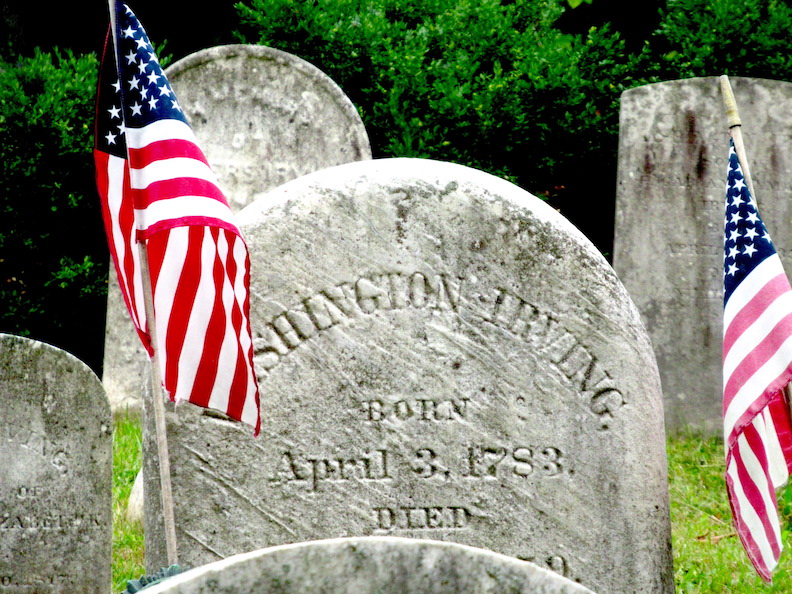
The headstone of author Washington Irving, shaded by hundred-year-old cedars and silver beeches in the Irving family plot, is among the most sought-out sights by visitors to Sleepy Hollow Cemetery. P hoto by Mark Orwoll
That rail line, though, as obnoxious as its cacophonous engines and ashen emissions might have been, was destined to change the face of the Hudson Valley. It steamed north carrying machinery, supplies, settlers, laborers, and other necessary elements of industry and growth.
And it carried more tourists.
Tourism Growth in the Hudson Valley
The American public grew enamored of the Hudson River Valley, especially in the 1830s and ’40s, thanks to the writings of Irving, but also to the works of the Hudson River School of art. Founded by English-born painter Thomas Cole, the Hudson River School was notable for its highly romantic landscape portraiture brimming with forested hills, waterfalls and the dramatic peaks of the nearby Catskill Mountains. The group included such names as the German-born Alfred Bierstadt, Asher B. Durand, Jasper Cropsey, and Frederic Church.
Several artists’ homes and studios, including Cole’s and Cropsey’s, are open to the public today, some 150 years later. The most lavish of them is Olana, the Victorian hilltop palace built by Frederic Church near Hudson in Greenport, NY. The rooms are covered with intricately patterned wallpaper, velvet curtains and Persian carpets that muffle elaborate staircases. The exterior, not to be outdone, boasts a sturdy tower, an arcaded piazza and patterned roof shingles, all surrounded by elegant gardens designed by the artist himself. Landscape painting in the middle of the 19th century paid all the bills.
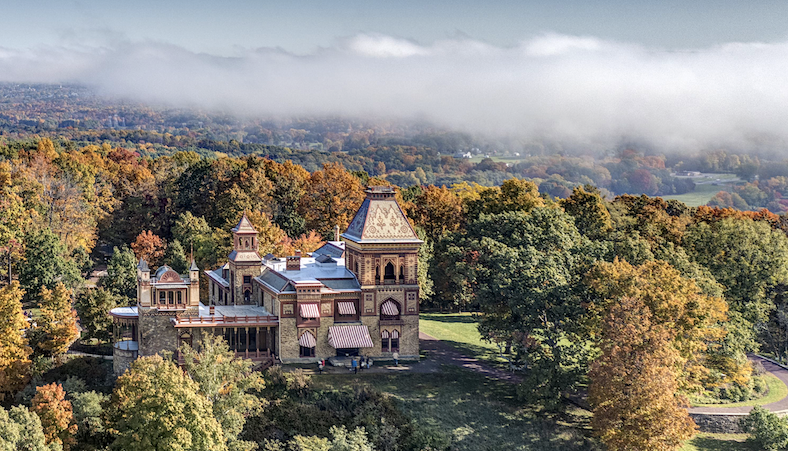
Popular 19th-century landscape artist Frederic Church built a magnificent mansion, called Olana, on a hill overlooking his creative inspiration, the Hudson River. Photo by Peter Aaron/OTTO, with permission
The Industrial Age on the Banks of the Hudson
Not long after America’s 1861-65 Civil War, the public began to tire of the Hudson River School. The Hudson River, however, had more to offer than just pretty scenery. The river was an ideal setting for factories, because the residual sludge, garbage, and sundry detritus of the Industrial Age could simply be dumped into the flow.
Riverfront factories required workers, and a growing number of villages sprang up after the Civil War to house and feed them: Peekskill, with its hellish foundries; Haverstraw, with its dangerous brick factories; Cold Spring, maker of munitions; Poughkeepsie, with its whale-rendering plants and paper mills; and Newburgh, with its woolen mills, tanneries, and bleach factories.
Fortunately for the modern-day traveler, these towns have made a comeback, or are trying to. Cold Spring, across the river from West Point, has gained a reputation as an antiques center. Tarrytown is one of the valley’s liveliest villages. Its handsome streets are lined with gaily painted Victorian commercial buildings, sidewalk cafés and hip bars.
Beacon, in the Mid-Hudson Valley, was once best known as the hometown of folk singer and activist Pete Seeger. Today it enjoys one of the region’s hottest housing markets, thanks to its beautiful setting overlooking the river and the bohemian flair of its shopping-and-entertainment district. Other towns and villages on both banks of the Hudson are attempting to achieve that same success in revitalizing their own fortunes.
Sleepy Hollow: A Typical River Town
Sleepy Hollow is one such village. Originally part of neighboring Tarrytown, it was spun off as North Tarrytown in the 19th century when it refocused its economy on industrialization instead of farming. German, Irish, and Italian immigrants came to work in the factories lining the Pocantico River, which runs through the village. As elsewhere along the Hudson, the factories often ran out of steam, leaving the town with an abundance of poor, underemployed immigrants.

The Headless Horseman, from Washington Irving’s story “The Legend of Sleepy Hollow,” parades down Broadway in Tarrytown during a Halloween celebration. Photo by Mark Orwoll
Then, in 1996, a brilliant bit of rebranding was brought before the town elders: a proposal to change the village’s name from North Tarrytown to—wait for it—Sleepy Hollow, as in Washington Irving’s beloved story, “The Legend of Sleepy Hollow.”
The actual location of Sleepy Hollow is a nearby narrow valley through which the Pocantico trickles toward the Hudson. Even today, it is still grassy and tree-covered, as it must have been when Washington Irving first saw the area as a boy while visiting a friend in Tarrytown. The village went all in. Street signs are imprinted with a logo of the Headless Horseman. Historic and “mystery” tours are frequently offered at Sleepy Hollow Cemetery. School groups and families flock to Philipsburg Manor to hear the period-garbed docents talk about the Dutch days. The Beekman Ale House slings Imperial IPAs and Czech pilseners in a woodsy, upscale setting.
Today, jazz concerts are held on the river at Horan’s Landing. Million-dollar waterfront condos have sprung up on the site of the old GM plant, which, ironically, left North Tarrytown the same year as the name changed to Sleepy Hollow.
North to Albany, the Capital
At the terminus of the Hudson’s navigable waters is Albany, 144 miles north of Midtown Manhattan. Home of the Mohican tribe, Albany was claimed by explorer Henry Hudson for the Netherlands in 1609. At that time, the Dutch controlled much of the Hudson Valley. But the English captured New Netherland (now New York State) in 1664 and gave the future capital its present name. Today, Albany is the oldest continuously chartered city in the United States.
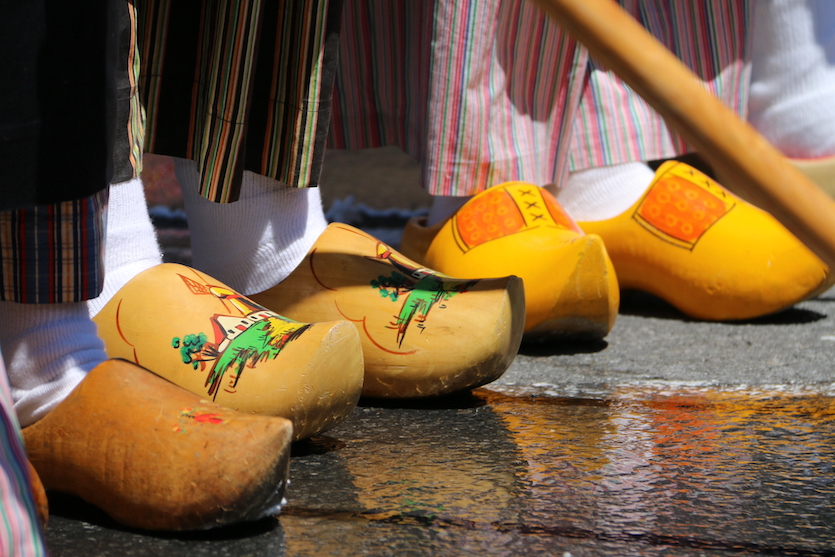
Traditional Dutch wooden shoes lend authenticity to dancers’ costumes during Albany’s annual Tulipfest in May, one of the state capital’s most popular festivals. Courtesy of Discover Albany
Despite the city’s wealth of historic architecture and its sophisticated arts scene, Albany is often derided as an unenlightened backwater by those who live south of the capital and consider New York City their cultural True North.
That parochial point of view is easily put to the test by visiting such institutions as the Cap Rep theater company, attending a concert at the art-deco Palace Theater, gazing at the space-age architecture of the Empire State Plaza, strolling among the exhibits of the New York State Museum, or examining the displays at the Albany Institute of History & Art, which has one of the most comprehensive collections of Hudson River School paintings to be seen anywhere. Founded in 1791, the Institute is one of America’s oldest museums.
The Erie Canal and the Way West
Besides becoming the permanent state capital in 1797, Albany played an even more pivotal role in the growth of the nation during the age of westward expansion, thanks to one of the most impressive construction feats of the early 19th century: the building of the Erie Canal.
The intensive growth of manufacturing plants on the Hudson necessitated a larger market than could be found in New England and the mid-Atlantic states. Hudson Valley products—bricks, paper, cement, iron, coal, wagons and shoes—needed to reach the growing communities of the Western frontier. But the long passage over mountains and vast uninhabited distances made it impractical until Governor DeWitt Clinton proposed the construction of a 363-mile canal from just north of Albany to Buffalo on the shores of Lake Erie.
Completed in 1825, four feet deep and 40 feet wide, the canal was a miracle of civil engineering. Before the canal, the trip from Albany to Buffalo could take weeks of slogging along muddy tracks. Once it was complete, the distance could be covered in just five days, From Buffalo, Hudson River trade goods could be forwarded to settlers in Illinois, Indiana and Ohio, or loaded onto sailing ships destined for the Great Lakes.
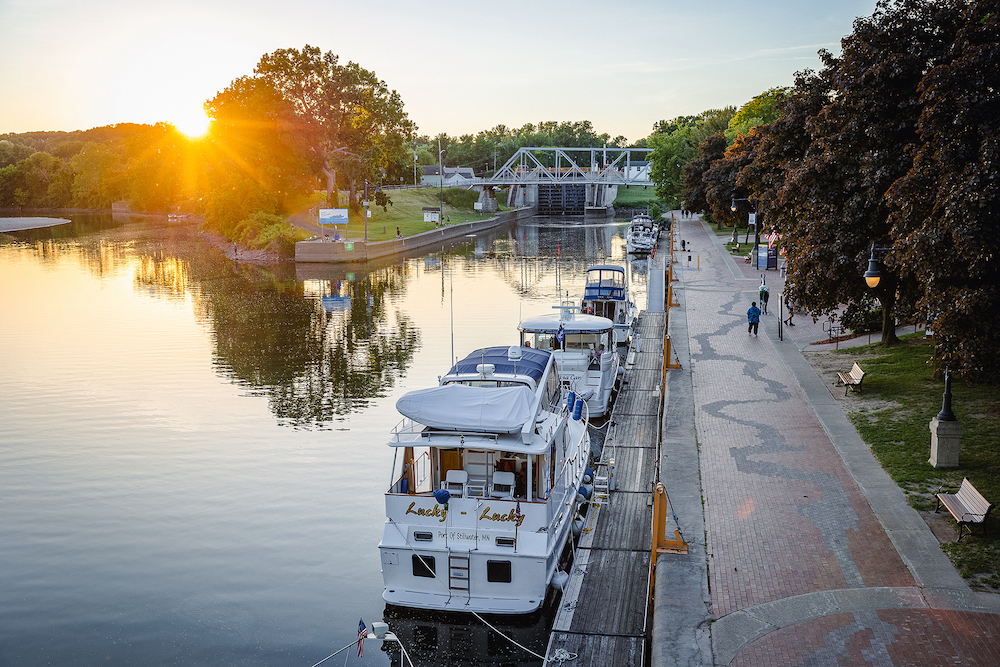
The Erie Canal fostered America’s westward expansion in the 19th century. Today, it is the haunt of pleasure boaters, as well as hikers who favor the old towpath. Courtesy of the Erie Canalway National Heritage Corridor
In return for all the bounty shipped west, pioneers on the other side of the Allegheny Mountains sent back grains and furs, products that powered America’s early economy.
But goods shipped on the canal weren’t limited to the mundane. Along with candles, hats, and muskets, canal boats carried news, political opinions and recently discovered products. The Erie Canal was America’s first information superhighway. Printing presses shipped to the frontier allowed even the smallest town to have its own newspaper. Today, because of its importance in American history, the waterway is designated the Erie Canalway National Heritage Corridor.
The Hudson River continues north of Albany for another 170 miles, clear to its source at Lake Tear of the Clouds in the Adirondack Mountains. But our journey ends at Albany, the terminus of the Hudson Valley and its charming villages, famous military academy, early Dutch towns and swiftly rushing river which continues to inspire the next chapter of America’s history.![]()
East-West News Service contributor Mark Orwoll has lived in the Hudson Valley for more than 25 years. The author of John Wayne Speaks, Orwoll’s recent articles described climate change in Austria and 5 locations that nurture the soul of America.

